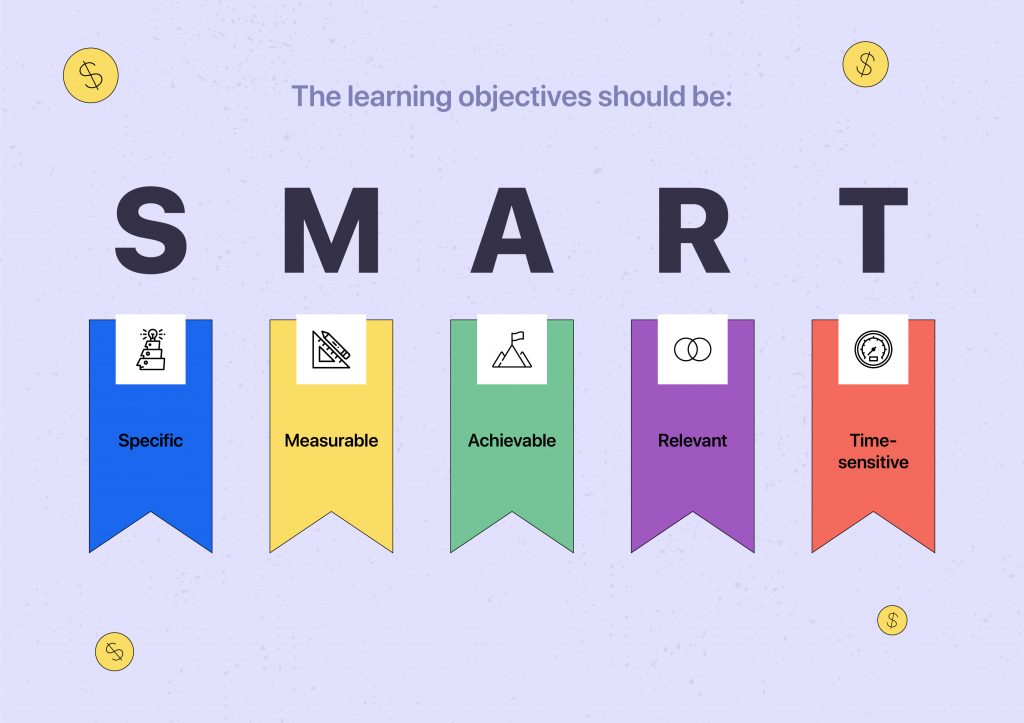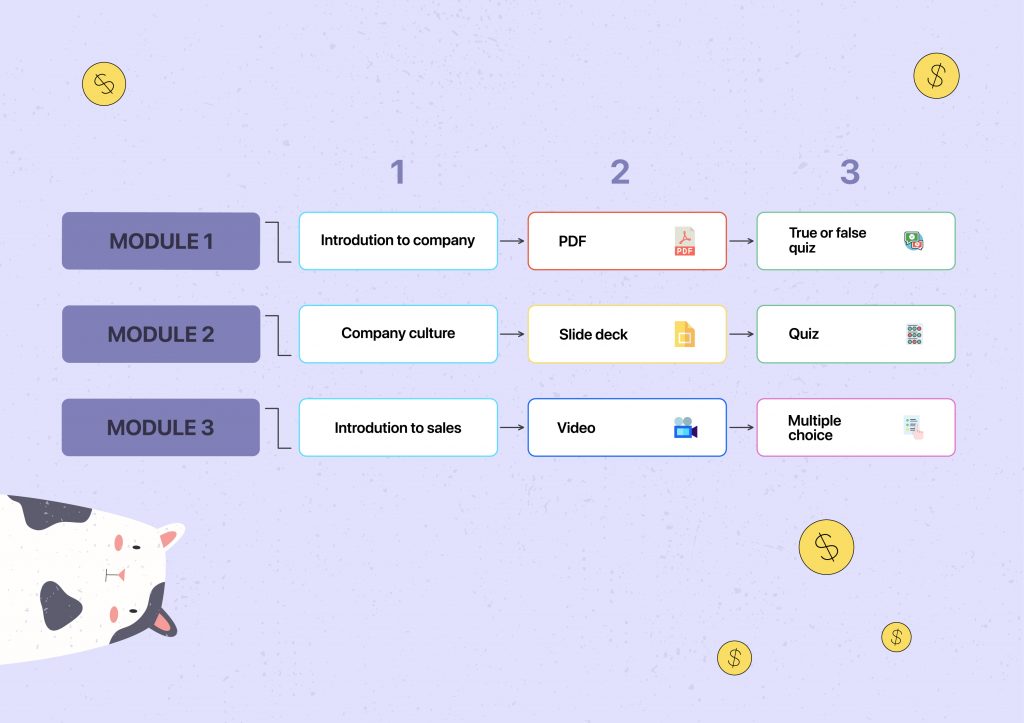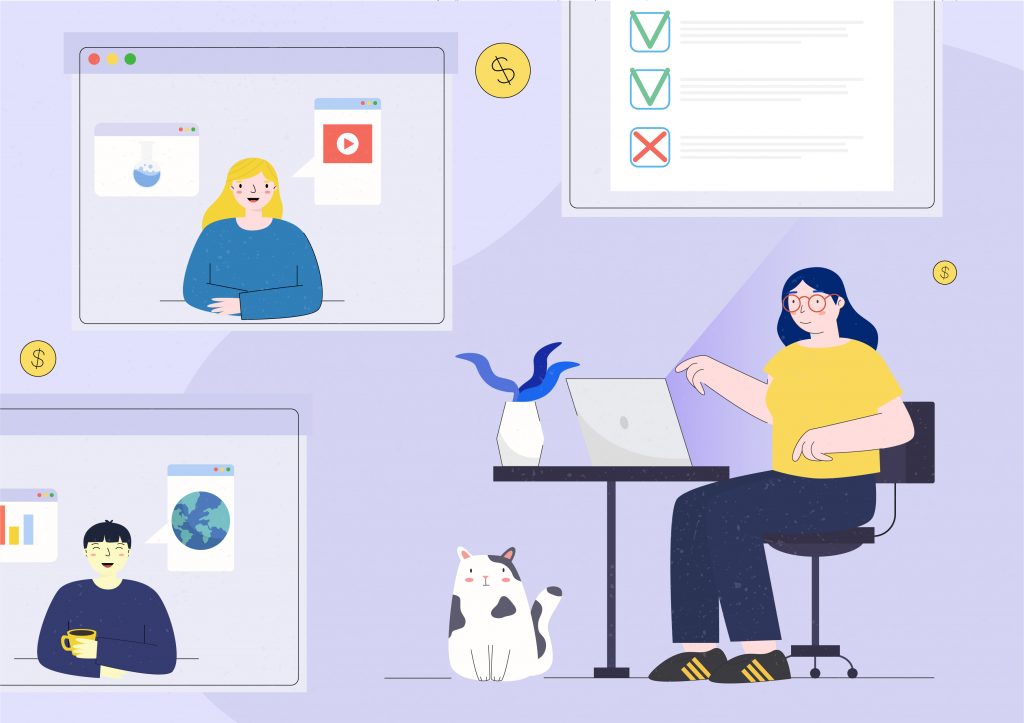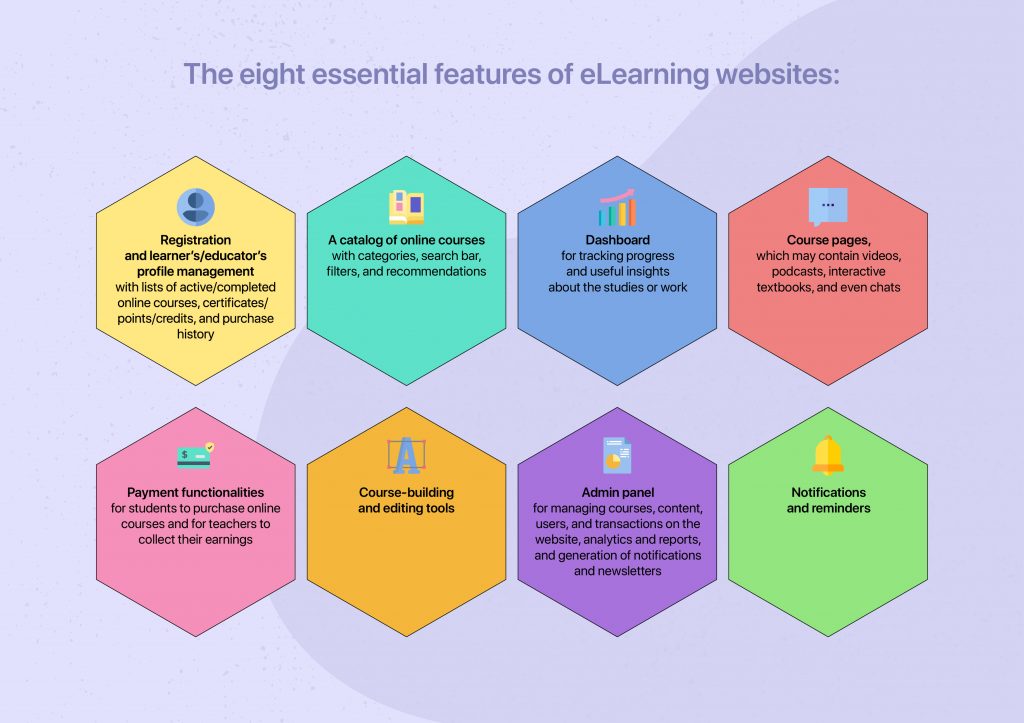8 Steps of a User-Friendly eLearning Course Development

The popularity of e-Learning, i.e. instruction delivered through Internet-connected devices, has been growing for years. The domain’s technologies currently range from smart pens to sophisticated artificial intelligence (AI) applications.
This post is dedicated to one of the simplest yet most marketable types of e-Learning websites — online courses. The high tuition and a lack of personalization in traditional educational institutions are driving students to obtain knowledge and college degrees online. Recruiters are regarding online certificates increasingly favorably. During the coronavirus crisis, even more users have appreciated the accessibility of such online education.
Here is a step-by-step guide on making an online course. Whether you are an investor, a professor looking to make extra money, or an employer needing to train workforce quickly, you may find some valuable tips here.
8 Steps for an Online Course Development
1. Need analysis
Start with defining your target audience and why they need this online course or training. The wider the audience, the better for the project. Flexibility and convenience for every learner are the core principles of eLearning.
The needs analysis can range from simple interviews to an in-depth analysis of data from years of workforce training. The needs analysis reveals not only what users actually need but also hopefully how you can meet their needs and get positive results.
Try to answer the following questions:
- What problem should your online course or courses solve?
- How can it potentially improve the users’ skills and knowledge?
- What are they interested in learning, and what interests them?
- How will your eLearning product help your organization/clients meet their business goals?
- What do you plan to achieve?
- How will you know whether you have reached your goal?
2. Research your audience and subject matter
Everything matters: the learners’ age, income level, existing knowledge, technical capabilities, expectations, available time, how they will use the new knowledge and skills, and even their interests and hobbies. For example, their favorite online education tools will provide ideas and inspiration. You can receive valuable insights via surveys, polls on social media, interviews, etc.
You also need to study your niche market to understand what solutions are popular, how they are generating income, and whether you can offer something unique to learners.
All this info will support you in developing relevant, practical, and engaging educational content. Knowing when and where your audience will be learning also influences the future course design. For example, if they do it on the go, a shorter course with easily digestible content and quick assessments is preferable.
Take the problem defined in Step 1 and collect information that addresses it specifically. Evaluate your existing source material and identify what you’re missing. If needed, engage a subject matter expert (SME) or experts. Most successful eLearning websites partner with universities, museums, celebrities, and others to amass rich content on various topics and present it interactively, so it may be high time to contact someone.
3. Formulate SMART learning objectives
Define the information or skills that learners should obtain by the end of the course.

The SMART goals should also be aligned to your business objectives.
Try to break down the existing content into manageable chunks according to the expected outcomes. This will help in creating online learning modules, the building blocks of your course: each module should teach a topic or a skill. Clear learning objectives will also prevent your eLearning content from swelling and digressing.
4. Develop the plan for your online course
The plan should be based on the project requirements, learning objectives, and the identified topics. Group the learning modules to devise a step-by-step learning experience. For each concept that students wish to master, they will watch video tutorials, read recommended materials, answer questions, etc. In the end, they would take a final test to prove their mastery and receive a certificate of completion, if applicable.
Have your SME or content writer put down the course plan considering the following:
- The type of content that best meets the learning objective and the learners’ individual needs
- What is the best way to make each learning module meaningful and relevant?
- How to make sure each learner masters the objectives?
The plan is not limited to a curriculum of sorts. The content of each learning module should be designed to support the learner’s intake and retention of critical information. Elaborate on the way the educational content will be delivered. It’s critical to hold the learners’ interest from one module to the next. The concept of waypoint is important as well. A course should be designed in such a way that users can pause anywhere and continue at any time without losing track. Even if busy learners don’t complete a course, they should still be left with some knowledge and general understanding, so they can easily resume learning when they need to.
Besides a user-friendly interface and engaging and relevant content, a proper assessment and rewards systems are important. You can also add a leaderboard system to make the experience more competitive. The best-performing learners may earn a discount on other courses or verified certificates upon course completion.
The stakeholders and SMEs should approve the plan.
5. Define the look-and-feel of the product
This task goes beyond choosing the images, colors, fonts, or animations. The learning experience should feel cohesive. Every element of the user interface (UI), user experience (UX), and learning content should support the overall idea and purpose of the course and create an emotional connection with every learner. For example, the tone of the voiceover in tutorials should match the ‘voice’ of the content writer. If you are creating content for senior citizens, you may choose a formal tone and a slower tempo of instruction, include more explanations, and so forth. If it targets children, the style will be completely different.
The assessments are part of the plan too. If instead of plain marks users can learn about their strengths and weaknesses, track their performance, and get rewards, it will motivate them to study and sustain an emotional connection with your online courses.
Although the visuals will be addressed later, start thinking about them now. The style of the future webpage, images, and printable materials should match the target audience’s tastes and needs, and so forth.
6. Design individual learning modules
Each eLearning module is a sequenced collection of subject-related materials and usually contains:
- 2-4 learning objectives for the module
- directions for use
- learning materials to help users understand or learn something
- learning activities to help them practice or apply the knowledge
- assessments
The learning outcomes are typically formulated like “learners will be able to: classify, describe, discuss, explain, identify, locate, recognize, report, select, translate, etc.” Once they have been nailed down, think about the ways to verify whether the learners achieved them. Assessments can occur at any point in a module, not necessarily at the end. Pop-up tests, quizzes, and exams are an interactive way of testing learners on the material they’ve covered thus far, but also breaking up the modules, keeping the learners’ attention, and motivating them to continue. Encourage the users’ feedback as well.
Describe the learning materials and activities for each module. If you are using a textbook, include the assigned readings from it. The trick is to transform the subject matter into something engaging, enlightening, and entertaining. Carefully select the content formats to use in each module: videos, webinars, charts, worksheets, and so forth. Besides conveying the ideas or explaining concepts most effectively, they should fit the learners’ needs and preferences. The variety of media, along with gamification, can help you engage learners and gain more users.

Storyboarding may be helpful at this stage. A rough visual outline will help you map out how text, videos, activities, quizzes, and other elements will look on a webpage, find out any gaps or parts that don’t fit together right, and so on.
7. Create or curate learning materials and activities for your course
This is the most complicated and time-consuming phase, the key areas including texts, graphics, video, audio, animations, interactions, and assessments. Luckily, there are plenty of free and paid authoring tools and resources that can help you with creating eLearning content. If your experience with programming and graphic design is limited, opt for a tool that features pre-made templates or a graphics library. Otherwise, choose software with advanced features and functions.
Some of the free and simple instruments for producing charts, infographics, or visuals are Canva, Gliffy, and Google Charts. Ardour, Voki, and vozMe are examples of free audio tools to help record, edit, mix, and download content for your online courses.
Use screen capture software like CamStudio, Free Cam, Free Screen Video Recorder, or ShareX to create videos easily. Camtasia, Screencast-O-Matic, and Snagit are some of the free tools to assist with editing and animations. Keep the video, audio, and graphic elements simple and straightforward: this will not only save time but also keep the focus of the course on what is truly important.
If there is no opportunity to develop custom multimedia elements, you can embed links to videos, presentations, or other online resources. It will still be useful and look professional; for example, videos from YouTube can be played directly on your course’s webpage.
For the creation of eLearning interactions and assessments, some of the accessible options include Easy Test Maker, Formsite, and Google Forms.
When you are writing or editing eLearning scripts and texts for the future webpages, try to avoid large blocks of text, write short sentences, and use bolded subheadings, bullet points, and numbered lists. If you are aiming at an international audience, follow a multi-lingual approach.
Arrange the materials and activities into a coherent sequence, as if guiding learners through them step-by-step. Include due dates, tips, and comments about how the content of this module is going to be useful and relates to the previous and future modules’ content. If you are asking users to read articles or view videos, supply guiding questions and instructions. Tell them what to look for, what to write down, and so forth.
8. Select the eLearning software, assemble a cohesive course, and publish it
Every element you include in the final product should serve the primary learning goals and business objectives.
Several free software programs provide all the tools you need to create screens, add graphics or video, include interactions, and ultimately compile your course. Easygenerator, iSpring, LCDS by Microsoft, SmartBuilder, and Udutu are good examples. Sometimes, layout templates can be customized to include branding, but it’s always best to pick a minimalistic theme with easily accessible UI elements.
Before compiling your online course, it is highly desirable to build a prototype of one learning module. A prototype defines the representative look-and-feel of the entire course and allows testing out its technical functionality. Advanced eLearning software enables course designers to make and discard multiple versions quickly before the best one is approved.
Once your online learning modules have been built and packaged into a course, you need to share it with your SMEs, company stakeholders, and clients, if any. Let them review it, suggest any changes, and ultimately approve. After that, you can move the course to one of the cloud eLearning platforms or learning management systems.
For example, at the Udemy platform, before publishing a course, you would have to submit it for quality review. Educators identify their ownership rights to the course, provide their legal name, DOB, country of residence and address, and go through a short verification process. After that, Udemy’s team reviews the course and, if no fixes are required, publishes it in the marketplace.
Alternatively, you can design an entire eLearning course with a learning management system (LMS). This software covers all your needs of administration, documentation, tracking, reporting, and delivery of online education.
After the publication, determine how effective your course has been. Collect statistics, analyze the learners’ feedback, reviews, and ratings, and otherwise try to learn what is more interesting, useful, and convenient for users, and what isn’t. Look at the return on investment, performance, and other key performance indicators as well. The continuous improvement and updates to your online courses are another task for LMS to handle, so let’s take a closer look at this software.

Learning Management Systems
Modern LMS offer reliable and convenient course-building and prototyping tools for individuals and organizations. Even without any instructional design knowledge, you can sign up with a platform like Docebo, SAP Litmos, or TalentLMS and access a wealth of capabilities. They will help you create a course structure, integrate your eLearning content and additional resources, drag-and-drop graphics and multimedia elements, integrate quizzes and exercises, leverage live streaming features, create calendars with assignment deadlines and learning events, and more.
When selecting eLearning authoring tools and LMS for your project, look at reviews from online course creators, available features, and costs, since many cloud-based LMS charge monthly fees. As for eLearning platforms, they would typically take a commission based on the number of learners enrolled for your course or charge a percentage of its cost.
Choose the software that best suits the needs of your audience and your organization’s preferences and needs. It’s time to look at new aspects of your online course development:
- How many users will be accessing the program simultaneously?
- Will it require any applications to be installed?
- Will the course be accessed on the company’s or the learner’s own devices?
- What is your plan for backing up information and security?
- What kind of support system will you offer?
A good LMS will help your courses look good in different web browsers and on smartphones and tablets. Consider this feature if your learners value the ability to access content and attend live classes on the go, without being always connected to the Internet. If you plan to charge fees, choose an eCommerce-enabled platform that will facilitate transactions and ensure the security of sensitive information.
WordPress, one of the most popular technologies, can help with the latter solution. Besides offering a plethora of plugins for virtually anything, from building a basic website to managing a video library, WordPress will require little to no tech expertise.
For example, Tutor LMS is an all-in-one solution suitable for individual educators, institutes, and eLearning platforms. It comes with a user-friendly interface, drag-and-drop system for eLearning course development, rich assessment options, and more. The entire course, regardless of its size, difficulty level, and the volume of content, can be created from a single page of the back-end course builder. You can attach worksheets and practice materials to download, add topics with quizzes and assignments, embed video sources or paste links to YouTube videos, and more. Tutor’s unique Frontend Course Builder allows new course developers to create quizzes and access all the back-end options right on the frontend. Tutor LMS also makes it easy to control course enrolments, add multiple instructors, and award custom certificates. It’s possible to create a website using the plugin’s free version only, while the Pro features will take your LMS to the next level.
If you plan on monetizing your eLearning content, the VooPlayer video hosting platform provides a solution for the secure storing and distribution of premium video content to subscribers. WooCommerce is a free and convenient eCommerce plugin for managing the sales of your online courses. As for the look-and-feel, WordPress offers various paid and free options for your LMS platform apart from the default theme.
With open-source LMS, you can further customize online learning experiences, certification programs, reporting and monitoring tools, and use a plethora of other useful plugins. Some of the examples are Canvas, Chamilo, Learning Locker LRS, Moodle, Open edX, and Totara Learn.They let course designers add their own features and integrate with other software.
Most of these cloud-based eLearning platforms claim to be easy to set up and use. Some are mobile-friendly. All are free. However, if you don’t have experience with programming, you might need to hire a web developer to help with:
- setting up your learning modules
- fully customizing the tools
- best implementation and integration
- setting up additional tools and pay-to-use features
- preventing problems with proprietary software
- some cluttered code
- bug fixes
One of the places to look for cutting-edge solutions is the Learning Technologies conference. Annually, in February, at the ExCeL center in London, 8,500 participants can attend 200+ free seminars and see 200 exhibits. Leading companies are preparing for the event throughout the year to showcase their achievements, so that you might explore the latest technologies and ideas and spy on innovations and development trends for the next year. Learning from the most experienced and successful entrepreneurs, you may increase the odds of success for your own eLearning project.
Custom Development of e-Learning Websites
If you are not content with any of the existing solutions and revenue models or wish to start a brand-new online courses marketplace, you may create e-Learning website from scratch. It’s highly recommended to start with a minimum viable product (MVP).

You may complement this minimum with whatever unique features you envision. With the current advances in technology, such as AI or virtual reality, learners are increasingly selective and demanding of online education. Only websites and applications with at least one ‘killer’ feature can stand out from the crowd of competitors and retain learners.
Data privacy and security features may become one of the competitive advantages. If the vital features are designed right from the concept stage, the product development will be more cost-effective, UX better, and the path to market safer and smoother.
A successful eLearning project is actually never complete. Its life cycle may span 4-5 years and more, and to stay relevant, it should be constantly improved and reinvented. New features are introduced, while outdated and unused ones disappear. A project with a rigid plan may take 18 months to complete, after which the product is already outdated and nobody wants it. That’s why an MVP and Agile approach are the best for eLearning development.
Final Thoughts
The process of building websites for online education can be roughly divided into two parts. The first pertains to the development of specific content according to approved online course design. It requires familiarity with instructional design and content authoring tools, but little, if any, programming skill.
The second part requires that you should choose and leverage technology solutions for the publication and distribution of eLearning content and possibly revenue generation. For example, with the right learning management system, you can easily scale and deploy various online courses and corporate training programs. However, even the best eLearning platforms are quite complex, may require a significant learning curve, and often call for the assistance of professional software developers.
For most entrepreneurs, a DIY approach isn’t worth the time, effort, and even money. Besides learning how to create content and design e-Learning websites, they and their employees surely have other business needs to attend. It’s more reasonable to concentrate on generating income while a trusted expert handles everything about your eLearning product, from devising a long-term strategy to fixing bugs. Moreover, if you opt for outsourcing the project, you can cut its cost dramatically.
At Alternative-spaces, we know that building effective eLearning solutions takes work, cutting-edge technology, creativity, and years of experience. Our offshore software development services range from consulting to full custom UI/UX design and development of eLearning websites and mobile applications. Our specialists can also work as an extension of your in-house team. Whatever help you may need, please don’t hesitate to get in touch!
Content created by our partner, Onix-systems.
 Home
Home